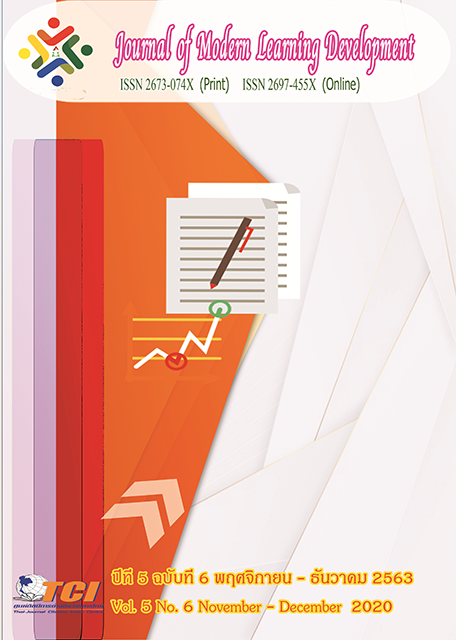Buddhist methods of human resource management in organizations for excellence in the digital age
Main Article Content
Abstract
Buddhism, the method of administering the Sangha is to not do good, do good to be ready to brighten the mind. Adopting people into an organization is the consideration of accepting people who accept discipline. Personnel management within the organization is the appointment and assignment of duties according to their abilities, called "Attak". And dissemination of the mission of the organization is to distribute manpower to carry out the assigned duties. Human resources in the digital age organization Need to rely on social media programs Must develop themselves to keep up with all-round technology Especially technology that relates to their responsibilities Which need to be developed according to appropriate processes Both attending training The continuing education assessment can be applied to all aspects of the organization. In which every process creates good relationships between associates at all levels Bring to the disclosure of pros and cons, problems and obstacles in the performance of duties.
Article Details
References
กัญญามน อินหว่าง และวรรณพร พุทธภูมิพิทักษ์. (2552). ทฤษฎีองค์การและการจัดการ. พิษณุโลก: มหาวิทยาลัยพิษณุโลก.
กิติมา ปรีดีดิลก. (2532). การบริหารและการนิเทศการศึกษาเบื้องต้น. กรุงเทพมหานคร: อักษรเจริญทัศน์.
กิติมา ปรีดีดิลก. (2542). ทฤษฎีบริหารองค์การ. (พิมพ์ครั้งที่ 4). กรุงเทพมหานคร: ธนะการพิมพ์.
จิตรลดา อมรวัฒนา. (2553). การศึกษาเปรียบเทียบปัจจัยที่ส่งผลต่อความมีประสิทธิผลของการบริหารทรัพยากรมนุษย์เชิงกลยุทธ์: กรณีศึกษาบริษัทภายใต้อุตสาหกรรมที่ใช้เทคโนโลยีระดับต่ำกับอุตสาหกรรมที่ใช้เทคโนโลยีระดับสูง. วารสารบริหารธุรกิจ, 33 (125), 46-78.
ชลวิทย์ เจียรจิตต์. (2559). องค์กรทางพระพุทธศาสนาในสังคมไทยยุคปฏิรูป. วารสารสังคมศาสตร์ มหาวิทยาลัยศรีนครินทรวิโรฒ,19 (1), 60-71.
ณัฎฐพันธ์ เขจรนันทน์. (2545). การจัดการทรัพยากรมนุษย์. กรุงเทพมหานคร : บริษัท ซีเอ็ดยูเคชั่น จำกัด (มหาชน).
ธีร์รัฐ ทิพย์นพนนท์. (2560). การพัฒนาทรัพยากรมนุษย์ของสำนักงานตำรวจแห่งชาติตามหลักพุทธวิถี. วารสาร มจร การพัฒนาสังคม, 2 (3), 49-60.
ประคอง สุคนธจิตต์. (2562). ทรัพยากรมนุษย์ยุค 4.0. วารสารมนุษยศาสตร์และสังคมศาสตร์นายเรืออากาศ, 7 (1), 17-28.
พระครูวินัยธรจักรี ศรีจารุเมธีญาณ, สัญญา เคณาภูมิ และวิทยา เจริญศิริ. (2559). บทบาทพระสงฆ์ไทยในสังคมยุคโลกาภิวัตน์. วารสารสันติศึกษาปริทรรศน์ มจร, 4 (1), 275 -287.
พระครูสังฆรักษ์พิทยา ญาณธโร (ปิยวรากุล). (2561). ศึกษาการเผยแผ่พระพุทธศาสนาในประเทศไทยยุคดิจิทัล. วิทยานิพนธ์ปริญญาพุทธศาสตรมหาบัณฑิต สาขาวิชาพระพุทธศาสนา. บัณฑิตวิทยาลัย : มหาวิทยาลัยมหาจุฬาลงกรณราชวิทยาลัย.
พระพรหมคุณาภรณ์ (ป.อ. ปยุตฺโต). (2559). พจนานุกรมพุทธศาสตร์ ฉบับประมวลธรรม. (พิมพ์ครั้งที่ 36). กรุงเทพมหานคร: สำนักพิมพ์ผลิธัมม์.
พิชิต เทพวรรณ. (2554). การจัดการทรัพยากรมนุษยเชิงกลยุทธ : แนวคิดและกลยุทธเพื่อความไดเปรียบทางการแขงขัน. กรุงเทพมหานคร: ซีเอ็ดยูเคชั่น.
สมบัติ กุสุมาวลี. (2552). การบริหารทรัพยากรมนุษยในองคกรตามหลักปรัชญาของเศรษฐกิจพอเพียง.กรุงเทพมหานคร: สมาคมการจัดกรงานบุคคลแหงประเทศไทย.
สุนันทา เลาหนันทน. (2556). การบริหารทรัพยากรมนุษย. กรุงเทพมหานคร: ธนการพิมพ.
เสนาะ ติเยาว์. (2534). การบริหารบุคคล. (พิมพ์ครั้งที่ 8). กรุงเทพมหานคร: โรงพิมพ์มหาวิทยาลัยธรรมศาสตร์.
เสาวลักษณ์ โกศลกิตติอัมพร และสัญญา เคณาภูมิ. (2559). หลักการเบื้องต้นเกี่ยวกับองค์การและการจัดการ. วารสารวิชาการแพรวากาฬสินธุ์ มหาวิทยาลัยกาฬสินธุ์, 3 (1), 170-194.
อำนวย แสงสว่าง. (2540). การจัดการทรัพยากรมนุษย์. กรุงเทพมหานคร: โรงพิมพ์ทิพยวิสุทธิ์.
Happyhew. (2020). ความหมายขององค์กรและองค์การ. Online. สืบค้นเมื่อ 26 สิงหาคม 2563. from : https://happyhew.com/2017/01/18
HR NOTE. (2020). การพัฒนาองค์กร (Organization Development : OD) ให้ก้าวสู่ความสำเร็จ. Online. สืบค้นเมื่อ 26 สิงหาคม 2563. from :https://th.hrnote.asia/orgdevelopment /190610- organization-development-od/
Marketeer Team. (2016). เปิดยุค Digital 1.0-4.0. Online. สืบค้นเมื่อ 26 สิงหาคม 2563. from :https://marketeeronline.co/archives/24632
Pucki, V., Tichy, N. M., & Barnett, C. K. (Eds.). (1992). Globalizing management: Creating and leading the competitive organization. New York: Wiley.
STEPS Academy. (2017). วัฒนธรรมองค์กรกับบุคลากรในยุคดิจิตอล. Online. สืบค้นเมื่อ 26 สิงหาคม 2563. from :https://stepstraining.co/foundation/team-culture-and-human-resource-in-digital-era


